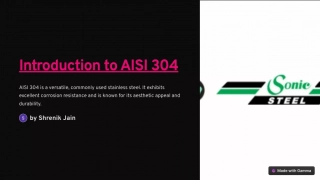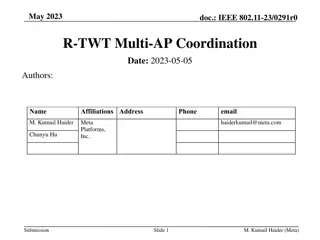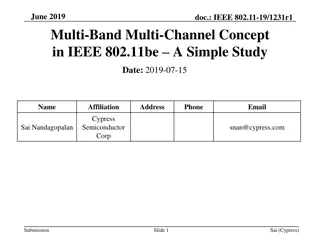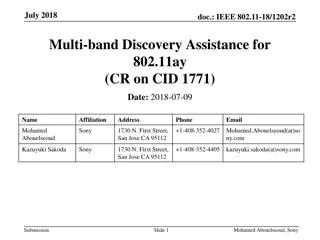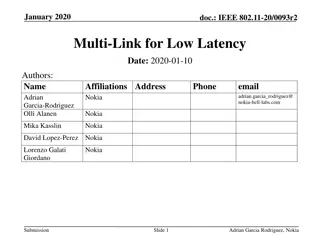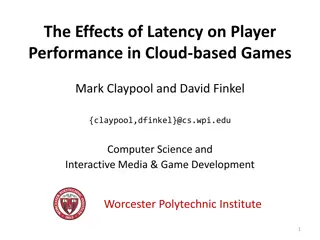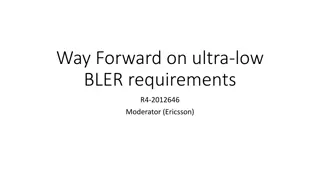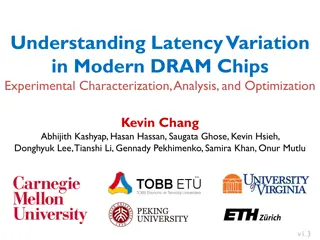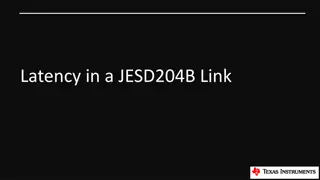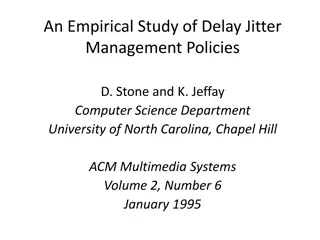
IEEE 802.11-19/1615r1 Multi-band Multi-link Operation for Low Latency
Explore the proposal for multi-band/multi-channel operation in IEEE 802.11-19/1615r1 to enhance worst-case latency and jitter performance for real-time data transmission. The document discusses the benefits of multi-link aggregation, requirements for optimization, and channel access methods for improved low-latency and jitter performance.
Download Presentation

Please find below an Image/Link to download the presentation.
The content on the website is provided AS IS for your information and personal use only. It may not be sold, licensed, or shared on other websites without obtaining consent from the author. If you encounter any issues during the download, it is possible that the publisher has removed the file from their server.
You are allowed to download the files provided on this website for personal or commercial use, subject to the condition that they are used lawfully. All files are the property of their respective owners.
The content on the website is provided AS IS for your information and personal use only. It may not be sold, licensed, or shared on other websites without obtaining consent from the author.
E N D
Presentation Transcript
2019 doc.: IEEE 802.11-19/1615r1 Multi-band/Multi-channel(Multi-link) Operation for Low Latency and Jitter Date: 2019-11-7 Authors: Name Affiliation Address Phone Email Liuming Lu ZTE Corporation No.889 Bibo Road, Shanghai, P.R.China lu.liuming@zte.com.cn Liquan Yuan Bo Sun ZTE Corporation No.9 Wu Xing Section, Xi Feng Road, Xi an, Shaanxi Province, P.R.China Nan Li Submission 1 Liuming Lu, etc, ZTE
2019 doc.: IEEE 802.11-19/1615r1 Introduction Multi-link operation has been proposed as a main candidate feature in TGbe. And at least one mode of operation capable of improved worst case latency and jitter will be defined in TGbe.[1][2] This contribution gives some views on multi-link operation to improve worst case latency and jitter for the real-time transmission of RTA data. Submission 2 Liuming Lu, etc, ZTE
2019 doc.: IEEE 802.11-19/1615r1 Background Multi-link operation can improve the worst case latency and jitter since it uses two or more bands or channels (links) to transmit data and the effective control of the traffic transmission on different links is beneficial to the improvement of latency performance. However how much multi-link operation can improve the worst case latency and jitter needs to be considered. Multi-band operation has been specified in the current 802.11 standard, which supports transparent fast session transfer (FST) and nontransparent FST, but lacks the detailed mechanisms to support the real-time transmission of RTA data. The current 802.11 standard has specified admission control at the HC which supports two distinct admission control mechanisms: one for contention based access and another for controlled access. The contention based admission control is for ACs with EDCA parameters, and no admission control for links is involved. Submission 3 Liuming Lu, etc, ZTE
2019 doc.: IEEE 802.11-19/1615r1 Requirements for the optimization of multi-link operation Contribution[3] has presented latency gains with multi-link aggregation, showing that adding an auxiliary link significantly improves the worst-case latency. But the latency gains seem to be not enough to support the RTA, such as virtual reality or augmented reality. RTA use cases and requirements (examples) [4] Use cases Real-time gaming Cloud gaming Intra BSS latency/ms < 5 < 10 Jitter variance/ms < 2 < 2 Packet loss < 0.1 % Near-lossless Data rate/Mbps < 1 <0.1 >5Mbps (Forward link) (Reverse link) < 3 ~ 10 < 1~ 2.5 Real-time video Near-lossless 100 ~ 28,000 Latency gain results of simulation [3] MCS0 1 OBSS STA per link 2 OBSS STAs per link 4 OBSS STAs per link 8 OBSS STAs per link 9.24 22.89 61.88 325.2 Multi (80MHz+20MHz) Link The mechanisms for multi-link operation, such as channel access method, time scheduling, admission control etc., need to be optimized to satisfy the requirements for low-latency and jitter performance. Submission 4 Liuming Lu, etc, ZTE
2019 doc.: IEEE 802.11-19/1615r1 Channel access methods for multi-link operation Flexible channel access methods can be considered for multi-link operation. Different kinds of channel access methods can be respectively adopted for different links. The channel access methods to support time scheduling for RTA data are preferred to be adopted, and the contention-based channel access methods are suitable for the non-RTA data. For the manageable environment in some link HCCA can also be considered besides CSMA/CA and triggered-based channel access method. CSMA TXOPS CAP (Controlled Access Phase) link1 link1 Schedulable TXOPs for RTA data AP STAs CSMA TXOPS link2 link2 TXOPs through contention for non-RTA data Submission 5 Liuming Lu, etc, ZTE
2019 doc.: IEEE 802.11-19/1615r1 Admission control for multi-link operation Since admission control is a direct method to lower latency and jitter, flexible admission control strategies can be adopted for different bands or channels according the types of application, the priorities of the services, the types of STAs, etc. Different kinds of applications can be loaded on different bands or channels. For example, the RTA data which needs low latency and jitter is controlled to be transmitted on one channel or band, and the data of best-effort applications is controlled to be transmitted on the other channels or bands. The number of the STAs to access the channel which transmits the data of RTA applications is strictly limited to guarantee the low latency and jitter performance. Submission 6 Liuming Lu, etc, ZTE
2019 doc.: IEEE 802.11-19/1615r1 Conclusions The combination of multi-link operation, time scheduling and admission control needs to be considered to further lower the latency and jitter so as to satisfy the requirements for RTA. Flexible channel access methods can be considered for multi-link operation. Different kinds of channel access methods can be respectively adopted for different links according to the environment of the links and the types of the applications loaded on the links. Submission 7 Liuming Lu, etc, ZTE
2019 doc.: IEEE 802.11-19/1615r1 Straw Poll 1 Do you agree that admission control could be applied on each link independently? Y/N/A= Submission 8 Liuming Lu, etc, ZTE
2019 doc.: IEEE 802.11-19/1615r1 References 1. 11-18-1231-06-0eht-eht-draft-proposed-par, 802.11 EHT Proposed PAR 2. 11-18-1233-07-0eht-eht-draft-proposed-csd, IEEE 802.11 EHT draft Proposed CSD 3. 11-19-1081-01-00be-multi-link-aggregation-gain-analysis-latency,Multi- Link Aggregation: Latency Gains 4. 11-19-0065-06-0rta-rta-tig-summary-and-recommendations, RTA report summary Submission 9 Liuming Lu, etc, ZTE
2019 doc.: IEEE 802.11-19/1615r1 Thank you! Submission 10 Liuming Lu, etc, ZTE

